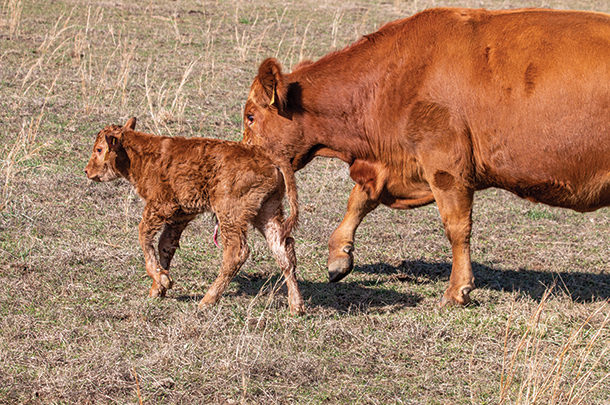We need to make sure we know where our calving equipment is, it’s clean and ready for use, and we know how and when to use it. We need to watch body condition of our cow herd and nutrition prior to calving to make sure cows calve in good condition. That’s important for calf health and quality colostrum. We need to address the calving environment and make sure it’s not too crowded, which accelerates buildup of calving-area contamination and mud. We need to provide some protection from the elements or severe weather and predators. We need to make sure all cattle have access to the water tanks and adequate feedbunk space. We need to make sure our staff knows how to identify when to help a heifer or cow during calving and how to identify and care for calves that are critical so every calf has a chance to thrive. We need to have the vet’s number handy so when we need to call we can get in touch with them. All of this helps lead to a successful calving season.
It is essential we respond to events in a timely, effective manner. How events turn out depends on our response. We also need to look at the whole picture. By recognizing and solving problems, we have better outcomes. By seeing the patterns in our operations, we prevent or reduce those problems beforehand. As the saying goes: “An ounce of prevention is worth a pound of cure.” There’s no doubt: Cure is good, but prevention is better.
Systems thinking looks at the whole, big picture. When we approach our production system focusing only on the next event, like calving season or breeding, we can miss the interrelated connections from one event to another. Our farms and ranches have production cycles – and cycles do just that; they go in cycles, with each activity or event leading into the next one. Activities in one event of the cycle impact the next either positively or negatively, possibly impacting subsequent cycles, resulting in a ripple effect. This goes on year after year.
We work in events and think about the system. Our processes are guided by our strategy.
As we understand events in the production cycle may be related, we might also discover why short-term solutions designed to solve an event problem aren’t as effective as we expected. For instance, trying to solve calving problems with calving ease genetics may not reduce dystocia if the problem is actually inadequate diet the last two months before calving. Or we might be disappointed if we use a scours vaccine prior to calving to reduce incidence of scours that is actually a calf health problem due to deficient trace minerals or overcrowding.
Maybe nutrition could be simplified by decreasing stocking rate (also reduces crowding and contamination) and removing unproductive stock. This may also reduce expensive supplements. While supplements may be necessary, they also need to be strategic and cost-effective.
A systems approach also helps us interpret our data or records. Records mean nothing if it doesn’t help us understand what is happening in our herds and why. We not only want to know what the overall success was in calving, we want to know “who” had poor outcomes, why and what can be done about it. For instance, if we had 90% of our cows calve successfully, what was the reason 10% didn’t? Were there similarities? Is there a pattern like age (young or older), body condition, same breeding pasture (possible sire or breeding environment), time of day or day of week (calving supervision), or if problems occurred during a specific period during calving, related to weather or other event? Was the information even recorded? Does the team know why we keep records?
Sometimes patterns emerge
Patterns help us see where time is well spent as well as what needs to be addressed. Recognizing patterns helps us focus efforts on successful solutions. With thin margins, busy schedules and overextended resources, we need to be efficient with our resources and waste as little precious time and effort as possible. As calving season begins and we read articles about how to help calves get off to a good start and feed cows for optimum fertility, we need to consider the costs associated with many of the recommendations in popular articles. We might see that some types of cattle do better than others. We might find we could be calving at the wrong time of year for our region of the country. Perhaps calving during a season better suited to calf survival or reducing expensive supplements might be needed. Don’t be afraid to ditch tradition if that’s what the evidence suggests. And don’t forget: Sometimes culling is the most effective solution.
This approach is especially applicable to part-time cattle producers. We need cattle that are nearly trouble-free. Many part-time producers would rather count calves than calve cows. Therefore, paying careful attention to the herd health and production system on the farm is critical for successful calf production.
The goal of cow-calf producers is to profitably produce resistant, resilient calves that have strong disease resistance and can handle the transitions from nursing, preconditioning, backgrounding or stockering to the feedlot or some finishing phase. While that seems far away while we are calving, as the saying goes: “We need to begin with the end in mind.”









